List of Assyrian kings
The king of Assyria (Akkadian: šar māt Aššur),[1] called the governor or viceroy of Assyria (Akkadian: Išši’ak Aššur)[2] in the Early and Old periods, was the ruler of the ancient Mesopotamian kingdom of Assyria, which existed from approximately the 26th century BC to the 7th century BC. All modern lists of Assyrian kings generally follow the Assyrian King List, a list kept and developed by the ancient Assyrians themselves over the course of several centuries. Though some parts of the list are probably fictional, the list accords well with Hittite, Babylonian and ancient Egyptian king lists and with the archaeological record, and is generally considered reliable for the age.
| King of Assyria | |
|---|---|
| šar māt Aššur | |
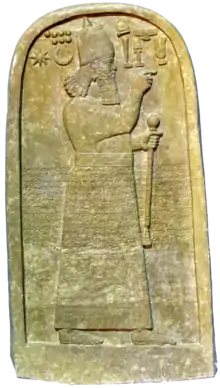 Stele of Adad-nirari III, r. 811–783 BC | |
| Details | |
| First monarch | Tudiya (traditional) Shalim-ahum (earliest contemporarily attested) |
| Last monarch | Ashur-uballit II |
| Formation | c. 2450 BC |
| Abolition | 609 BC |
| Appointer | Divine right, hereditary |
The ancient Assyrians did not believe that their king was divine himself, but saw their ruler as the vicar of their principal deity, Ashur, and as his chief representative on Earth. In their worldview, Assyria represented a place of order while lands not governed by the Assyrian king (and by extension, the god Ashur) were seen as places of chaos and disorder. As such it was seen as the king's duty to expand the borders of Assyria and bring order and civilization to lands perceived as uncivilized.
Originally vassals of more powerful empires, the early Assyrian kings used the title governor or viceroy (Išši’ak), which was retained as the ruling title after Assyria gained independence due to the title of king (šar) being applied to the god Ashur. Later Assyrian kings, beginning with Ashur-uballit I (14th century BC) adopted the title šar māt Aššur as their empire expanded and later also adopted more boastful titles such as "king of Sumer and Akkad", "king of the Universe" and "king of the Four Corners of the World", often to assert their control over all of Mesopotamia.
The line of Assyrian kings ended with the defeat of Assyria's final king Ashur-uballit II by the Neo-Babylonian Empire and the Median Empire in 609 BC, after which Assyria disappeared as an independent political unit, never to rise again. The Assyrian people survived and remain as an ethnic, linguistic, religious (most being Christians since the 1st–3rd centuries AD) and cultural minority in the Assyrian homeland and elsewhere to this day.
Sources
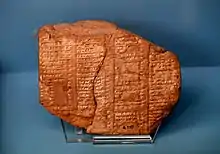
Incomplete king-lists have been recovered from all three of the major ancient Assyrian capitals (Aššur, Dur-Šarukkin and Nineveh). The three lists are largely consistent with each other, all originally copies of a single original list, and are based on the yearly appointments of limmu-officials (the eponymous officials for each year, appointed by the king to preside over the celebration of the New Year festival). Because of the consistency between the list and the method through which it was created, modern scholars usually accept the regnal years mentioned as more or less correct. There are some differences between the copies of the list, notably in that they offer somewhat diverging regnal years before the reign of king Ashur-dan I of the Middle Assyrian Empire (reign beginning in 1178 BC). After 1178 BC, the lists are identical in their contents.[3]
The king-lists mostly accord well with Hittite, Babylonian and ancient Egyptian king lists and with the archaeological record, and are generally considered reliable for the age.[4] It is however clear that parts of the list are fictional, as some known kings are not found on the list and other listed kings are not independently verified.[5] Originally it was assumed that the list was first written in the time of Shamshi-Adad I circa 1800 BC but it now is considered to date from much later, probably from the time of Ashurnasirpal I (1050–1031 BC).[6] The oldest of the surviving king-lists, List A (8th century BC) stops at Tiglath-Pileser II (c. 967–935 BC) and the youngest, List C, stops at Shalmaneser V (727–722 BC).[7]
One problem that arises with the Assyrian King List is that the creation of the list may have been more motivated by political interest than actual chronological and historical accuracy. In times of civil strife and confusion, the list still adheres to a single royal line of descent, probably ignoring rival claimants to the throne.[8] Additionally, there are some known inconsistencies between the list and actual inscriptions by Assyrian kings, often regarding dynastic relationships. For instance, Ashur-nirari II is stated by the list to be the son of his predecessor Enlil-Nasir II, but from inscriptions it is known that he was actually the son of Ashur-rabi I and brother of Enlil-Nasir.[9]
Titles
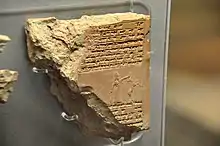
Assyrian royal titles typically followed trends that had begun under the Akkadian Empire (c. 2334–2154 BC), the Mesopotamian civilization that preceded the later kingdoms of Assyria and Babylon. When the Mesopotamian central government under the Third Dynasty of Ur (c. 2112–2004 BC) collapsed and polities that had once been vassals to Ur became independent, many of the new sovereign rulers refrained from taking the title of king (šar), instead applying that title to their principal deities (in the case of Assyria, Ashur). For this reason, most of the Assyrian kings of the Old Assyrian period (c. 2025–1378 BC) used the title Išši’ak Aššur, translating to "governor of Assyria".[10][2]
In contrast to the titles employed by the Babylonian kings in the south, which typically focused on the protective role and the piety of the king, Assyrian royal inscriptions tend to glorify the strength and power of the king.[11] Assyrian titularies usually also often emphasize the royal genaeology of the king, something Babylonian titularies do not, and also drive home the king's moral and physical qualities while downplaying his role in the judicial system.[12] Assyrian epithets about royal lineage vary in how far they stretch back, most often simply discussing lineage in terms of "son of ..." or "brother of ...". Some cases display lineage stretching back much further, Shamash-shuma-ukin (r. 667–648 BC) describes himself as a "descendant of Sargon II", his great-grandfather. More extremely, Esarhaddon (r. 681–669 BC) calls himself a "descendant of the eternal seed of Bel-bani", a king who would have lived more than a thousand years before him.[13]
Assyrian royal titularies were often changed depending on where the titles were to be displayed, the titles of the same Assyrian king would have been different in their home country of Assyria and in conquered regions. Those Neo-Assyrian kings who controlled the city of Babylon used a "hybrid" titulary of sorts in the south, combining aspects of the Assyrian and Babylonian tradition, similar to how the traditional Babylonian deities were promoted in the south alongside the Assyrian main deity of Ashur.[12] The assumption of many traditional southern titles, including the ancient "king of Sumer and Akkad" and the boastful "king of the Universe" and "king of the Four Corners of the World", by the Assyrian kings served to legitimize their rule and assert their control over Babylon and lower Mesopotamia.[14] Epithets like "chosen by the god Marduk and the goddess Sarpanit" and "favourite of the god Ashur and the goddess Mullissu", both assumed by Esarhaddon, illustrate that he was both Assyrian (Ashur and Mullissu, the main pair of Assyrian deities) and a legitimate ruler over Babylon (Marduk and Sarpanit, the main pair of Babylonian deities).[15]
To examplify an Assyrian royal title from the time Assyria ruled all of Mesopotamia, the titulature preserved in one of Esarhaddon's inscriptions read as follows[16]:
The great king, the mighty king, king of the Universe, king of Assyria, viceroy of Babylon, king of Sumer and Akkad, son of Sennacherib, the great king, the mighty king, king of Assyria, grandson of Sargon, the great king, the mighty king, king of Assyria; who under the protection of Assur, Sin, Shamash, Nabu, Marduk, Ishtar of Nineveh, Ishtar of Arbela, the great gods, his lords, made his way from the rising to the setting sun, having no rival.
Role of the Assyrian king
%252C_c._645-635_BC%252C_British_Museum_(16722368932).jpg.webp)
Ancient Assyria was an absolute monarchy, with the king believed to be appointed directly through divine right by the chief deity, Ashur.[17] The Assyrians believed that the king was the link between the gods and the earthly realm. As such, it was the king's primary duty to discover the will of the gods and enact this, often through the construction of temples or waging war. To aid the king with this duty, there was a number of priests at the royal court trained in reading and interpreting signs from the gods.[18]
The heartland of the Assyrian realm, Assyria itself, was thought to represent a serene and perfect place of order whilst the lands governed by foreign powers were perceived as infested with disorder and chaos.[17] The peoples of these "outer" lands were seen as uncivilized, strange and as speaking strange languages.[19] Because the king was the earthly link to the gods, it was his duty to spread order throughout the world through the military conquest of these strange and chaotic countries.[17] As such, imperial expansion was not just expansion for expansion's sake but was also seen as a process of bringing divine order and destroying chaos to create civilization.[19]
There exists several ancient inscriptions in which the god Ashur explicitly orders kings to extend the borders of Assyria. A text from the reign of Tukulti-Ninurta I (r. c. 1233–1197 BC) states that the king received a royal scepter and was commanded to "broaden the land of Ashur". A similar inscription from the reign of Ashurbanipal (r. 668–631 BC) commands the king to "extend the land at his feet".[19]
The king was also tasked with protecting his own people, often being referred to as a "shepherd". This protection included defending against external enemies and defending citizens from dangerous wild animals. To the Assyrians, the most dangerous animal of all was the lion, used (similarly to foreign powers) as an example of chaos and disorder due to their aggressive nature. To prove themselves worthy of rule and illustrate that they were competent protectors, Assyrian kings engaged in ritual lion hunts. Lion-hunting was reserved for Assyrian royalty and was a public event, staged at parks in or near the Assyrian cities.[17] In some cases, the hunt even took place with captive lions in an arena.[20]
Legitimacy
As opposed to some other ancient monarchies, such as ancient Egypt, the Assyrian king was not believed to be divine himself, but was seen as divinely chosen and uniquely qualified for the royal duties. Most kings stressed their legitimacy through their familial connections to previous kings; a king was legitimate through his relation to the previous line of great kings who had been chosen by Ashur. Usurpers who were unrelated to previous kings usually either simply lied about being the son of some previous monarch or claimed that they had been divinely appointed directly by Ashur.[19]
Two prominent examples of such usurpers are the kings Tiglath-Pileser III (r. 745–727 BC) and Sargon II (r. 722–705 BC). The inscriptions of these kings completely lack any familial references to previous kings, instead stressing that Ashur himself had appointed them directly with phrases such as "Ashur called my name", "Ashur placed me on the throne" and "Ashur placed his merciless weapon in my hand".[19]
Early Assyrian kings
As in the Sumerian king list, it is possible that some of the rulers listed below were contemporaries rather than predecessors and successors of each other.[21] No dates are provided by the Assyrian King List for kings preceding the Old Assyrian Empire, making the lengths of the reigns of these kings (many of which may not have existed at all) unknown.[3]
"Kings who lived in tents"
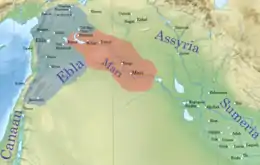
The intention of the author of the list, describing the first (probably all fictional, note the rhyming names) seventeen kings as "kings who lived in tents", was probably to indicate them as nomadic kings of the Assyrians.[3] Considering them "living in tents", these rulers (if they were real in the first place) probably did not govern the actual city of Aššur itself.[21] It is possible that the conclusion of this section on the king list would have indicated an end of the nomadic period of Assyrian history and the foundation of Aššur.[22] The sixteenth king, Ushpia, was designated by later Assyrians as the founder of the temple dedicated to Ashur in Aššur.[22]
| Name | Ref |
|---|---|
| Tudiya Tūdīja |
[3][23] |
| Adamu Adāmu |
[3][23] |
| Yangi Jangi |
[3][23] |
| Suhlamu Suḫlāmu |
[3][23] |
| Harharu Ḫarḫaru |
[3][23] |
| Mandaru Mandāru |
[3][23] |
| Imsu Imṣu |
[3][23] |
| Harsu Ḫarṣu |
[3][23] |
| Didanu Didānu |
[3][23] |
| Hana Ḫanû |
[3][23] |
| Zuabu Zuabu |
[3][23] |
| Nuabu Nuabu |
[3][23] |
| Abazu Abāzu |
[3][23] |
| Belu Bēlû |
[3][23] |
| Azarah Azaraḫ |
[3][23] |
| Ushpia Ušpia |
[3][23] |
"Kings who were ancestors"
The meaning of "kings who were ancestors" is unclear, this section is also the only section of the Assyrian king list to be written in reverted order for reasons unknown. The list mentions "ten kings who were ancestors" but includes the final king of the "kings who lived in tents", Apiashal, as one of them, possibly an error.[3] To avoid repetition, Apiashal has been left out of the previous section in this list.
| Name | Succession & notes | Ref |
|---|---|---|
| Apiashal Apiašal |
Son of Ushpia | [3][23] |
| Hale Ḫalê |
Son of Apiashal | [3][23] |
| Samani Samānu |
Son of Hale | [3][23] |
| Hayani Ḫajjāni |
Son of Samani | [3][23] |
| Ilu-Mer Ilī-Mēr |
Son of Hayani | [3][23] |
| Yakmesi Jakmesi |
Son of Ilu-Mer | [3][23] |
| Yakmeni Jakmeni |
Son of Yakmesi | [3][23] |
| Yazkur-el Jazkur-il |
Son of Yakmeni | [3][23] |
| Ila-kabkabu Ila-kabkabū |
Son of Yazkur-el | [3][23] |
| Aminu Aminu |
Son of Ila-kabkabu | [3][23] |
"Kings named on bricks whose eponyms are unknown"
The kings listed in this section would probably have been early rulers of Aššur.[7] King Kikkia is mentioned by later kings as having restored the inner city wall of Aššur.[24] In addition to the three kings listed here, three further kings are listed as "kings named on bricks whose eponyms are unknown" in the Assyrian king list,[7] but they are in this list presented in the following section due to their dynastic relationship to later kings.
| Name | Succession & notes | Ref |
|---|---|---|
| Sulili Sulili |
Son of Aminu | [3][23] |
| Kikkia Kīkkia |
Unclear succession | [3][23] |
| Akiya Akīa |
Unclear succession | [3][23] |
Old Assyrian kings (c. 2025–1366/1353 BC)
Dynasty of Puzur-Ashur
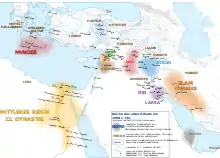
The period beginning with Puzur-Ashur I's reign is sometimes referred to as the Dynasty of Puzur-Ashur.[25] Puzur-Ashur's line saw the beginning of true Akkadian names in the Assyrian royal line as opposed to earlier names which may have corresponded closer to Hurrian names.[21]
| Name | Succession & notes | Ref |
|---|---|---|
| Puzur-Ashur I Puzur-Aššur |
Unclear succession | [3] |
| Shalim-ahum Šallim-aḫḫe |
Son of Puzur-Ashur I | [3] |
| Ilu-shuma Ilu-šūma |
Son of Shalim-ahum | [3] |
| Erishum I Erišum |
Son of Ilu-shuma | [3] |
| Ikunum Ikūnum |
Son of Ilu-shuma | [3] |
| Sargon I Šarru-ukīn |
Son of Ikunum | [3] |
| Puzur-Ashur II Puzur-Aššur |
Son of Sargon I | [3] |
| Naram-Sin Narām Sîn |
Son of Puzur-Ashur II | [3] |
| Erishum II Erišum |
Son of Naram-Sin | [3] |
Dynasty of Shamshi-Adad
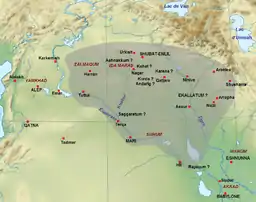
Also referred to as the period of Amorite domination over Assyria.[26]
| Name | Succession & notes | Ref |
|---|---|---|
| Shamshi-Adad I Šam-ši-Adad |
Usurper; possibly a descendant of Sulili | [3] |
| Ishme-Dagan I Išme-Dagān |
Son of Shamshi-Adad I | [3] |
| Mut-Ashkur Mut-Aškur |
Son of Ishme-Dagan I | [3][27] |
| Rimush Rimuš |
Unclear relation; descendant of Shamshi-Adad I | [3][27] |
| Asinum Asīnum |
Grandson of Shamshi-Adad I | [3][27] |
Seven usurpers
After the end of Shamshi-Adad's dynasty, seven competing claimants reigned for a total of just six years. Ashur-dugul appears to have ruled throughout most of the period, making the extent of the rule of the other usurpers unclear.[28]
| Name | Succession & notes | Ref |
|---|---|---|
| Ashur-dugul Aššur-dugul |
Usurper; unrelated to previous kings | [3][27] |
| Ashur-apla-idi Aššur-apla-iddina |
Usurper; unrelated to previous kings; extent of rule unclear | [3][27] |
| Nasir-Sin Nāsir Sîn |
Usurper; unrelated to previous kings; extent of rule unclear | [3][27] |
| Sin-namir Sîn-nāmir |
Usurper; unrelated to previous kings; extent of rule unclear | [3][27] |
| Ipqi-Ishtar Ipqi-Ištar |
Usurper; unrelated to previous kings; extent of rule unclear | [3][27] |
| Adad-salulu Adad-salulu |
Usurper; unrelated to previous kings; extent of rule unclear | [3][27] |
| Adasi Adasi |
Usurper; unrelated to previous kings; extent of rule unclear | [3][27] |
Adaside dynasty (c. 1700/1680–745 BC)
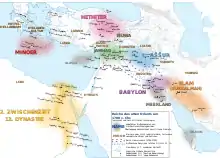
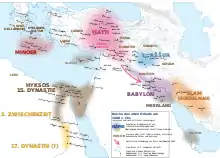
The Adasides ruled Assyria from the middle of the Old Assyrian period to the dynasty's fall (and replacement by the Sargonid dynasty) in the middle of the Neo-Assyrian period, ruling for nearly a thousand years.[29] From this section and onwards, the list records the dates of royal reigns in both the Middle chronology (indicated with MC) and Short chronology (indicated with SC), competing chronologies of ancient Mesopotamian history. The Middle Chronology tends to be favored by modern researchers.[30][31][32]
| Name | Reign | Succession & notes | Ref |
|---|---|---|---|
| Bel-bani Bēlu-bāni |
1700 – 1691 BC (MC) 1680 – 1671 BC (SC) |
Son of Adasi | [3][27] |
| Libaya Libaia |
1690 – 1674 BC (MC) 1670 – 1654 BC (SC) |
Son of Bel-bani or Adasi | [3][27] |
| Sharma-Adad I Šarma-Adad |
1673 – 1662 BC (MC) 1653 – 1642 BC (SC) |
Son of Libaya or Adasi | [3][27] |
| Iptar-Sin Ib-Tar-Sîn |
1661 – 1650 BC (MC) 1641 – 1630 BC (SC) |
Son of Sharma-Adad I or Adasi | [3][27] |
| Bazaya Bāzāiu |
1649 – 1622 BC (MC) 1629 – 1602 BC (SC) |
Son of Iptar-Sin or Bel-bani | [3][27] |
| Lullaya Lulāiu |
1621 – 1616 BC (MC) 1601 – 1596 BC (SC) |
Usurper; unrelated to the Adaside dynasty | [3][27] |
| Shu-Ninua Šu-Ninua |
1615 – 1602 BC (MC) 1596 – 1583 BC (SC) |
Son of Bazaya | [3][27] |
| Sharma-Adad II Šarma-Adad |
1601 – 1598 BC (MC) 1582 – 1580 BC (SC) |
Son of Shu-Ninua | [3][27] |
| Erishum III Erišum |
1598 – 1586 BC (MC) 1579 – 1567 BC (SC) |
Son or brother of Sharma-Adad II | [3][27][33] |
| Shamshi-Adad II Šam-ši-Adad |
1585 – 1580 BC (MC) 1567 – 1561 BC (SC) |
Son of Erishum III | [3][27] |
| Ishme-Dagan II Išme-Dagān |
1580 – 1564 BC (MC) 1561 – 1545 BC (SC) |
Son of Shamshi-Adad II | [3][27] |
| Shamshi-Adad III Šam-ši-Adad |
1564 – 1548 BC (MC) 1545 – 1529 BC (SC) |
Nephew of Sharma-Adad II | [3][27][33] |
| Ashur-nirari I Aššur-nārāri |
1548 – 1522 BC (MC) 1529 – 1503 BC (SC) |
Son of Ishme-Dagan II | [3][27] |
| Puzur-Ashur III Puzur-Aššur |
1522 – 1498 BC (MC) 1503 – 1479 BC (SC) |
Son of Ashur-nirari I | [3][27] |
| Enlil-nasir I Enlīl-nāsir |
1498 – 1485 BC (MC) 1479 – 1466 BC (SC) |
Son of Puzur-Ashur III | [3][27] |
| Nur-ili Nur-ili |
1485 – 1473 BC (MC) 1466 – 1454 BC (SC) |
Son of Enlil-nasir I | [3][27] |
| Ashur-shaduni Aššur-šaddûni |
1473 BC (MC) 1454 BC (SC) |
Son of Nur-ili | [3][27] |
| Ashur-rabi I Aššur-rabi |
1473 – 1433 BC (MC) 1453 – 1435 BC (SC) |
Son of Enlil-nasir I; usurped the throne from Ashur-shaduni | [3][27] |
| Ashur-nadin-ahhe I Aššur-nādin-ahhē |
1433 BC (MC) 1435 – 1420 BC (SC) |
Son of Ashur-rabi I | [3][27] |
| Enlil-nasir II Enlīl-nāsir |
1433 – 1427 BC (MC) 1420 – 1414 BC (SC) |
Son of Ashur-rabi I; usurped the throne from Ashur-nadin-ahhe I | [3][27] |
| Ashur-nirari II Aššur-nārāri |
1427 – 1420 BC (MC) 1414 – 1407 BC (SC) |
Son of Ashur-rabi I | [3][27] |
| Ashur-bel-nisheshu Aššūr-bēl-nīšēšu |
1420 – 1411 BC (MC) 1407 – 1398 BC (SC) |
Son of Ashur-nirari II | [3][27] |
| Ashur-rim-nisheshu Aššūr-rā’im-nīšēšu |
1411 – 1403 BC (MC) 1398 – 1390 BC (SC) |
Son of Ashur-nirari II | [3][27] |
| Ashur-nadin-ahhe II Aššur-nādin-ahhē |
1403 – 1393 BC (MC) 1390 – 1380 BC (SC) |
Son of Ashur-rim-nisheshu | [3][27][33] |
| Eriba-Adad I Erība-Adad |
1393 – 1366 BC (MC) 1380 – 1353 BC (SC) |
Son of Ashur-bel-nisheshu or Ashur-rim-nisheshu | [3][27][33] |
Middle Assyrian kings (1365/1353–912 BC)
Adaside dynasty (continued)
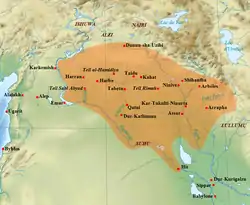
| Name | Reign | Succession & notes | Ref |
|---|---|---|---|
| Ashur-uballit I Aššur-uballiṭ |
1365 – 1330 BC (MC) 1353 – 1318 BC (SC) |
Son of Eriba-Adad I | [3][34] |
| Enlil-nirari Enlīl-nārāri |
1329 – 1320 BC (MC) 1317 – 1308 BC (SC) |
Son of Ashur-uballit I | [3][34] |
| Arik-den-ili Arīk-den-ili |
1319 – 1308 BC (MC) 1307 – 1296 BC (SC) |
Son of Enlil-nirari | [3][34] |
| Adad-nirari I Adad-nārārī |
1307 – 1275 BC (MC) 1295 – 1264 BC (SC) |
Son of Arik-den-ili | [3][34] |
| Shalmaneser I Salmānu-ašarēd |
1274 – 1245 BC (MC) 1263 – 1234 BC (SC) |
Son of Adad-nirari I | [3][34] |
| Tukulti-Ninurta I Tukultī-Ninurta |
1244 – 1208 BC (MC) 1233 – 1197 BC (SC) |
Son of Shalmaneser I | [3][34] |
| Ashur-nadin-apli Aššūr-nādin-apli |
1207 – 1204 BC (MC) 1196 – 1194 BC (SC) |
Son of Tukulti-Ninurta I; usurped the throne from his father | [3][34] |
| Ashur-nirari III Aššur-nārāri |
1203 – 1198 BC (MC) 1193 – 1188 BC (SC) |
Son or nephew of Ashur-nadin-apli | [3][34] |
| Enlil-kudurri-usur Enlilbe-kudúr-uṣur |
1197 – 1193 BC (MC) 1187 – 1183 BC (SC) |
Son of Tukulti-Ninurta I; usurped the throne from Ashur-nirari III | [3][34] |
| Ninurta-apal-Ekur Ninurta-apal-ekur |
1192 – 1180 BC (MC) 1182 – 1180 BC (SC) |
Descendant of Adad-nirari I; usurped the throne from Enlil-kudurri-usur | [3][34] |
| Ashur-dan I Aššur-dān |
1179 – 1134 BC | Son of Ninurta-apal-Ekur; regnal dates from Ashur-dan I onwards are consistent in all chronologies | [3][34] |
| Ninurta-tukulti-Ashur Ninurta-tukultī-Aššur |
1133 BC | Son of Ashur-dan I | [3][34] |
| Mutakkil-nusku Mutakkil-nusku |
1133 BC | Son of Ashur-dan I; usurped the throne from Ninurta-tukulti-Ashur | [3][34] |
| Ashur-resh-ishi I Aššur-rēša-iši |
1132 – 1115 BC | Son of Mutakkil-nusku | [3][34] |
| Tiglath-Pileser I Tukultī-apil-Ešarra |
1114 – 1076 BC | Son of Ashur-resh-ishi I | [3][34] |
| Asharid-apal-Ekur Ašarēd-apil-Ekur |
1075 – 1074 BC | Son of Tiglath-Pileser I | [3][34] |
| Ashur-bel-kala Aššūr-bēl-kala |
1073 – 1056 BC | Son of Tiglath-Pileser I | [3][34] |
| Eriba-Adad II Erība-Adad |
1055 – 1054 BC | Son of Ashur-bel-kala | [3][34] |
| Shamshi-Adad IV Šam-ši-Adad |
1053 – 1050 BC | Son of Tiglath-Pileser I; usurped the throne from Eriba-Adad II | [34] |
| Ashurnasirpal I Aššur-nāṣir-apli |
1049 – 1031 BC | Son of Shamshi-Adad IV | [3][34] |
| Shalmaneser II Salmānu-ašarēd |
1030 – 1019 BC | Son of Ashurnasirpal I | [3] |
| Ashur-nirari IV Aššur-nārāri |
1018 – 1013 BC | Son of Shalmaneser II | [3] |
| Ashur-rabi II Aššur-rabi |
1012 – 972 BC | Son of Ashurnasirpal I | [3] |
| Ashur-resh-ishi II Aššur-rēša-iši |
971 – 967 BC | Son of Ashur-rabi II | [3] |
| Tiglath-Pileser II Tukultī-apil-Ešarra |
967 – 935 BC | Son of Ashur-resh-ishi II | [3] |
| Ashur-dan II Aššur-dān |
935 – 912 BC | Son of Tiglath-Pileser II | [3] |
Neo-Assyrian kings (912–609 BC)
Adaside dynasty (continued)
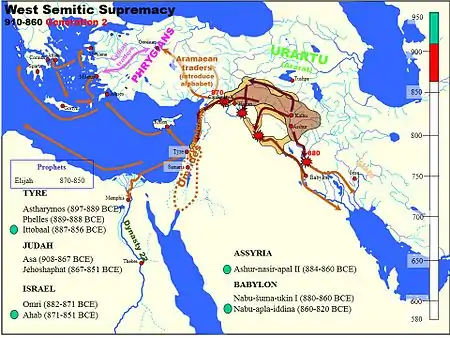


| Image | Name | Reign | Succession & notes | Ref |
|---|---|---|---|---|
| — | Adad-nirari II Adad-nārārī |
912 – 891 BC | Son of Ashur-dan II | [3] |
| — | Tukulti-Ninurta II Tukultī-Ninurta |
891 – 884 BC | Son of Adad-nirari II | [3][35] |
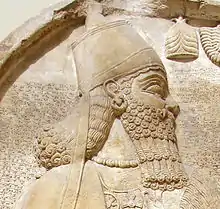 |
Ashurnasirpal II Aššur-nāṣir-apli |
884 – 859 BC | Son of Tukulti-Ninurta II | [3][35] |
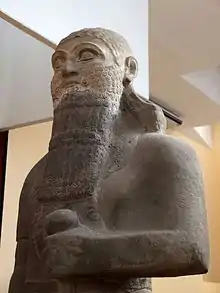 |
Shalmaneser III Salmānu-ašarēd |
859 – 824 BC | Son of Ashurnasirpal II | [3][35] |
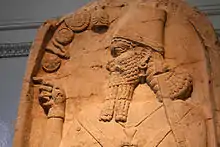 |
Shamshi-Adad V Šam-ši-Adad |
824 – 811 BC | Son of Shalmaneser III | [3][35] |
 |
Adad-nirari III Adad-nārārī |
811 – 783 BC | Son of Shamshi-Adad V | [3][35] |
| — | Shalmaneser IV Salmānu-ašarēd |
783 – 773 BC | Son of Adad-nirari III | [3][35] |
| — | Ashur-dan III Aššur-dān |
773 – 755 BC | Son of Adad-nirari III | [3][35] |
| — | Ashur-nirari V Aššur-nārāri |
755 – 745/744 BC | Son of Adad-nirari III | [3][35][36] |
 |
Tiglath-Pileser III Tukultī-apil-Ešarra |
745 – 727 BC | Son of Adad-nirari III or Ashur-nirari V | [3][37][38][36][39] |
 |
Shalmaneser V Salmānu-ašarēd |
727 – 722 BC | Son of Tiglath-Pileser III | [3][35] |
Sargonid dynasty (722–609 BC)

| Image | Name | Reign | Succession & notes | Ref |
|---|---|---|---|---|
.jpg.webp) |
Sargon II Šarru-kīn |
722 – 705 BC | Claimed to be the son of Tiglath-Pileser III; usurped the throne from Shalmaneser V | [3][35][40] |
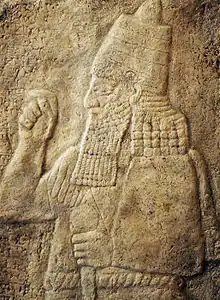 |
Sennacherib Sîn-aḥḥē-erība |
705 – 681 BC | Son of Sargon II | [3][35] |
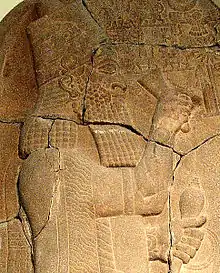 |
Esarhaddon Aššur-aḫa-iddina |
681 – 669 BC | Son of Sennacherib | [3][35] |
.jpg.webp) |
Ashurbanipal Aššur-bāni-apli |
669 – 631 BC | Son of Esarhaddon | [41][42] |
| — | Ashur-etil-ilani Aššur-etel-ilāni |
631 – 627 BC | Son of Ashurbanipal | [42] |
| — | Sinsharishkun Sîn-šar-iškun |
627 – 612 BC | Son of Ashurbanipal | [42] |
 |
Sin-shumu-lishir Sîn-šumu-līšir |
626 BC | General of Ashur-etil-ilani; rebelled against Sinsharishkun and attempted to claim the throne for himself | [43] |
| — | Ashur-uballit II Aššur-uballiṭ |
612 – 609 BC | Unclear relation; possibly the son of Sinsharishkun | [44][45] |
See also
- List of kings of Babylon – for the Babylonian kings
- List of Mesopotamian dynasties – for other dynasties and kingdoms in ancient Mesopotamia
- Sumerian King List – for legendary and historical Sumerian kings, rulers of Mesopotamia before the Assyrians and Babylonians
- Adiabene – a later Assyrian/Syriac kingdom from 15 to 116 AD
- Osroene – a later Assyrian/Syriac kingdom from 132 BC to 214 AD, ruled by kings of Arabic origin
References
Citations
- Karlsson 2017, p. 2.
- Liverani 2013.
- Assyrian King List.
- Rowton 1970, pp. 194–195.
- La Boda 1994, p. 89.
- Azize 1998, p. 1–27.
- Meissner 1990, p. 101–102.
- Hagens 2005, p. 24.
- Hagens 2005, p. 27.
- Hallo 1980, p. 193.
- Stevens 2014, p. 73.
- Karlsson 2017, p. 1.
- Karlsson 2017, p. 12.
- Soares 2017, p. 21.
- Soares 2017, p. 28.
- Luckenbill 1927, p. 211.
- British Museum.
- Melville 2016, pp. 219–229.
- Parker 2011, pp. 357–386.
- Reade 1998b, pp. 72–79.
- Roux 1994, p. 187.
- Rowton 1970, pp. 202–204.
- Glassner 2004, p. 137.
- Lewy 1966, p. 21.
- Roux 1994, p. 543.
- Dumbrill 2015, p. 97.
- Ancient Egypt and Archaeology.
- Radner 1998, p. 179.
- Veenhof & Eidem 2008, p. 24.
- Kuhrt 1997, p. 12.
- Mieroop 2015, p. 4.
- Sagona & Zimansky 2009, p. 251.
- Newgrosh 1999, p. 80.
- Kuhrt 1995, p. 351.
- Manser & Reid 2012, p. 114.
- Davenport 2016, pp. 37–41.
- Frye, Wolfram & Dietz 2016.
- Radner 2016, p. 47.
- Garelli 1991, p. 46.
- Mark 2014.
- Lipschits 2005, p. 15.
- Na’aman 1991, p. 243.
- Lipschits 2005, p. 13.
- Reade 1998, p. 260.
- Radner 2019, pp. 135–141.
Bibliography
- Azize, Joseph (1998). "Who was responsible for the Assyrian King List?". Abr-Nahrain. 35: 1–27.
- Davenport, T. L. (2016). Situation and Organisation: The Empire Building of Tiglath-Pileser III (745-728 BC) (PDF) (PhD thesis). University of Sydney.
- Dumbrill, Richard (2015). Musical Scenes and Instruments on seals, sealings and impressions from the Ancient Near East. Lulu. ISBN 9781326289324.
- Frye, Richard N.; Wolfram, Th. von Soden; Dietz, O. Edzard (15 April 2016). "History of Mesopotamia". Encyclopædia Britannica.
- Garelli, Paul (1991). "The Achievement of Tiglath-pileser III: Novelty or Continuity?" (PDF). In Cogan, M.; Eph'al, I. (eds.). Studies in Assyrian History and Ancient Near Eastern Historiography Presented to Hayim Tadmor. Jerusalem: Magnes.
- Glassner, Jean-Jacques (2004). Mesopotamian Chronicles. Society of Biblical Literature. ISBN 978-1589830905.
- Hagens, Graham (2005). "The Assyrian King List and Chronology: a Critique". Orientalia. 74 (1): 23–41. JSTOR 43076931.
- Hallo, William W. (1980). "Royal Titles from the Mesopotamian Periphery". Anatolian Studies. 30: 189–195. doi:10.2307/3642789. JSTOR 3642789.
- Karlsson, Mattias (2017). "Assyrian Royal Titulary in Babylonia". S2CID 6128352. Cite journal requires
|journal=(help) - Kuhrt, Amélie (1995). The Ancient Near East, C. 3000-330 BC, Volume 1. Routledge. ISBN 0-415-01353-4.
- Kuhrt, Amélie (1997). Ancient Near East c. 3000–330 BC. Routledge. ISBN 978-0-415-16763-5.
- La Boda, Sharon (1994). International Dictionary of Historic Places: Middle East and Africa. Taylor & Francis. ISBN 978-1884964039.
- Lewy, Hildegard (1966). The Cambridge Ancient History: Assyria c. 2600-1816 B.C.
- Lipschits, Oled (2005). The Fall and Rise of Jerusalem: Judah under Babylonian Rule. Eisenbrauns. ISBN 978-1575060958.
- Liverani, Mario (2013). The Ancient Near East: History, Society and Economy. Routledge. ISBN 978-0415679060.
- Luckenbill, Daniel David (1927). Ancient Records of Assyria and Babylonia Volume 2: Historical Records of Assyria From Sargon to the End. University of Chicago Press.
- Manser, Martin H.; Reid, Debra (2012). Who's who of the Bible. Lion Books. ISBN 978-0745955186.
- Meissner, Bruno (1990). Reallexikon der Assyriologie. Walter de Gruyter. ISBN 978-3110100518.
- Melville, Sarah C. (2016). "The Role of Rituals in Warfare during the Neo-Assyrian Period". Religion Compass. 10 (9): 219–229. doi:10.1111/rec3.12206. ISSN 1749-8171.
- Van Der Mieroop, Marc (2015). A History of the Ancient Near East, ca. 3000-323 BC. John Wiley & Sons. ISBN 978-1405149112.
- Na’aman, Nadav (1991). "Chronology and History in the Late Assyrian Empire (631—619 B.C.)". Zeitschrift für Assyriologie. 81 (1–2): 243–267. doi:10.1515/zava.1991.81.1-2.243. S2CID 159785150.
- Newgrosh, Bernard (1999). "The Chronology of Ancient Assyria Re-assessed" (PDF). Journal of the Ancient Chronology Forum. 8: 78–88.
- Parker, Bradley J. (2011). "The Construction and Performance of Kingship in the Neo-Assyrian Empire". Journal of Anthropological Research. 67 (3): 357–386. doi:10.3998/jar.0521004.0067.303. ISSN 0091-7710. JSTOR 41303323.
- Radner, Karen (1998). The Prosopography of the Neo-Assyrian Empire, Volume 1, Part I: A. The Neo-Assyrian Text Corpus Project.
- Radner, Karen (2016). "Revolts in the Assyrian Empire: Succession Wars, Rebellions Against a False King and Independence Movements". In Collins, John J.; Manning, J. G. (eds.). Revolt and Resistance in the Ancient Classical World and the Near East: In the Crucible of Empire. Brill Publishers. ISBN 978-9004330184.
- Radner, Karen (2019). "Last Emperor or Crown Prince Forever? Aššur-uballiṭ II of Assyria according to Archival Sources". State Archives of Assyria Studies. 28: 135–142.
- Reade, J. E. (1998). "Assyrian eponyms, kings and pretenders, 648-605 BC". Orientalia (NOVA Series). 67 (2): 255–265. JSTOR 43076393.
- Reade, J. E. (1998). Assyrian Sculpture. The British Museum Press. ISBN 978-0714121413.
- Roux, Georges (1992). Ancient Iraq. Penguin Books Limited. ISBN 9780140125238.
- Rowton, M. B. (1970). The Cambridge Ancient History. Cambridge University Press. ISBN 978-0521070515.
- Sagona, A.; Zimansky, P. (2009). Ancient Turkey. Routledge. ISBN 978-0-415-28916-0.
- Soares, Filipe (2017). "The titles 'King of Sumer and Akkad' and 'King of Karduniaš', and the Assyro-Babylonian relationship during the Sargonid Period" (PDF). Rosetta. 19: 20–35.
- Stevens, Kahtryn (2014). "The Antiochus Cylinder, Babylonian Scholarship and Seleucid Imperial Ideology" (PDF). The Journal of Hellenic Studies. 134: 66–88. doi:10.1017/S0075426914000068. JSTOR 43286072.
- Tadmor, Hayim (1994). The Inscriptions of Tiglath-Pileser III, King of Assyria: Critical Edition, with Introductions, Translations, and Commentary. Jerusalem: Israel Academy of Sciences and Humanities.
- Veenhof, Klaas R.; Eidem, Jesper (2008). Mesopotamia: The Old Assyrian Period. Academic Press Fribourg. ISBN 978-3727816239.
Web sources
- "Ancient Egypt and Archaeology Web Site - Ancient Egypt - Assyrian". www.ancient-egypt.co.uk. Retrieved 2019-11-13.
- "Introducing the Assyrians". The British Museum Blog. 2018-06-19. Retrieved 2019-11-21.
- "The Assyrian King List - Livius". www.livius.org. Retrieved 2 April 2019.
- Joshua J., Mark. "Sargonid Dynasty - Ancient History Encyclopedia". www.ancient.eu. Retrieved 2 April 2019.
